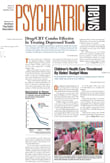The widespread distress felt across the United States following the terrorist attacks of September 11, 2001, was not accompanied by a significant upward trend in the utilization of psychotropic medications. However, a formal review of prescription medication data now confirms the conclusions of a preliminary analysis of the same data by Psychiatric News, which noted a small but statistically significant increase in the utilization of psychotropic medications in the New York City area (Psychiatric News, November 16, 2001).
The results of the formal review, conducted by Benjamin Druss, M.D., M.P.H., an associate professor of psychiatry at Emory University in Atlanta, and Steven Marcus, Ph.D., of the University of Pennsylvania School of Social Work in Philadelphia, were published in the August American Journal of Psychiatry. The work was supported by a grant from the National Institute of Mental Health.
Druss and Marcus used two sources for prescription data “to ensure both breadth and depth of data about medication use.” The first dataset came from NDCHealth, a national data warehouse that collects information about more than two-thirds of the prescriptions filled in the United States and then projects these data to aggregate nationwide, regional, and local estimates of medication usage. The second dataset came from AdvancePCS, the largest pharmacy benefits management (PBM) organization in the United States. AdvancePCS processes more than 450 million pharmacy claims a year.
NDCHealth provided Druss and Marcus with weekly projections of psychotropic medication utilization nationally and in the New York and Washington, D.C., areas. The NDCHealth data represented weekly averages, so the team used them to provide a comprehensive overview of psychotropic medication use over time for antidepressants, antipsychotic/antimanic medications, anxiolytics, and hypnotic medications.
AdvancePCS provided complete data for all prescriptions for psychotropic medications filled by the PBM between September 2001 and December 2001. Data from the same period in 2000 were used as a comparison.
The AdvancePCS data represented depersonalized individual prescription records including not only the date the prescription was filled, the drug dispensed, and its strength and quantity, but also age, sex, and ZIP code of the patient and a variable indicating whether the patient had had the same prescription filled within the prior 365 days.
Druss and Marcus again subdivided the data into the same four major medication groups as the NDCHealth data.
The researchers found that 156.9 million prescriptions for psychotropics were filled during the study period. Nationally and in Washington, D.C., the team found no evidence of any increase in overall psychotropic prescriptions, the number of new prescriptions, or the dosage of medications. However, in New York City, there was an increase in the proportion of patients taking psychotropic medications and who increased their dosages in the 12 weeks following September 11, compared with the proportion who increased their dosages during the same 12 weeks in 2000 (13.6 percent). Yet in New York City, there was still no increase in the number of new psychotropic prescriptions filled.
“For certain subpopulations—in particular, certain subgroups of patients already taking psychotropic medications—there was a small but consistent increase in the use of these medications,” Druss and Marcus concluded. “Taken together, this evidence suggests that initial predictions of a drastic increase in [psychotropic medication] use after September 11 were not realized.”
Druss and Marcus hypothesized that several reasons could account for a lack of any apparent effect. First, they said, “it is possible that patients who needed care failed to obtain access to it.” Second, they added, individuals may have been symptomatic, yet did not see themselves in need of formal mental health services.
“Finally,” the researchers noted, “many people are likely to have sought help through friends and family, local communities, or clergy.
Druss and Marcus acknowledged that the study results must be interpreted with some limitations. “The data sets had considerably more breadth than depth,” they wrote. The data did not include any diagnostic information or clinical data on treatments other than pharmacotherapy.
Am J Psychiatry 2004 161 1377
